When selecting flooring for basements, it’s essential to focus on moisture resistance, durability, and style. Options such as luxury vinyl plank, tile, and carpet tiles not only withstand damp conditions but also enhance the aesthetic appeal of the space. By choosing the right materials, you can prevent water damage and mold growth while ensuring your basement remains functional and inviting for years to come.
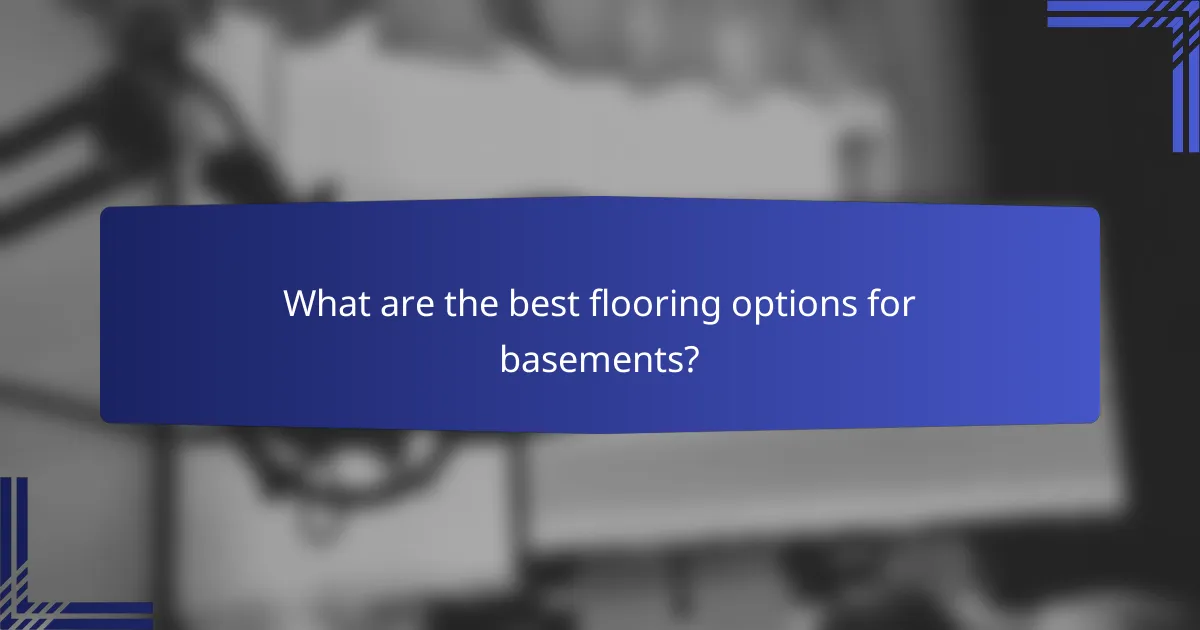
What are the best flooring options for basements?
The best flooring options for basements prioritize moisture resistance, durability, and style. Choices like luxury vinyl plank, tile, and carpet tiles are popular due to their ability to withstand damp conditions while providing aesthetic appeal.
Luxury vinyl plank
Luxury vinyl plank (LVP) is a top choice for basement flooring because it is highly resistant to moisture and water damage. This material mimics the look of hardwood or stone while being more affordable and easier to maintain.
When selecting LVP, consider the thickness and wear layer, as these factors influence durability. Look for products with a warranty of at least 10 years to ensure long-lasting performance.
Tile flooring
Tile flooring is another excellent option for basements, especially ceramic or porcelain tiles, which are inherently moisture-resistant. Tiles come in various styles, colors, and sizes, allowing for creative design choices.
Ensure proper installation with a waterproof underlayment to prevent moisture issues. While tile can be cold underfoot, adding area rugs can enhance comfort and style.
Carpet tiles
Carpet tiles offer flexibility and comfort, making them a suitable choice for basement flooring. They are easy to install and replace, which is beneficial if a tile becomes damaged or stained.
Choose carpet tiles specifically designed for moisture-prone areas to enhance durability. Look for options with a waterproof backing to further protect against potential water damage.
Engineered hardwood
Engineered hardwood combines real wood with a plywood base, making it more stable and resistant to moisture than traditional hardwood. This flooring option provides the warmth and beauty of wood while being suitable for basements.
When selecting engineered hardwood, check the thickness of the veneer layer and the quality of the core. A thicker veneer can be sanded and refinished, extending the lifespan of your flooring.
Laminate flooring
Laminate flooring is a cost-effective alternative that can mimic the appearance of wood or stone. It is designed to resist scratches and moisture, making it a practical choice for basements.
Look for laminate with a high AC rating, which indicates durability. Ensure proper installation with a moisture barrier to prevent water damage from below.
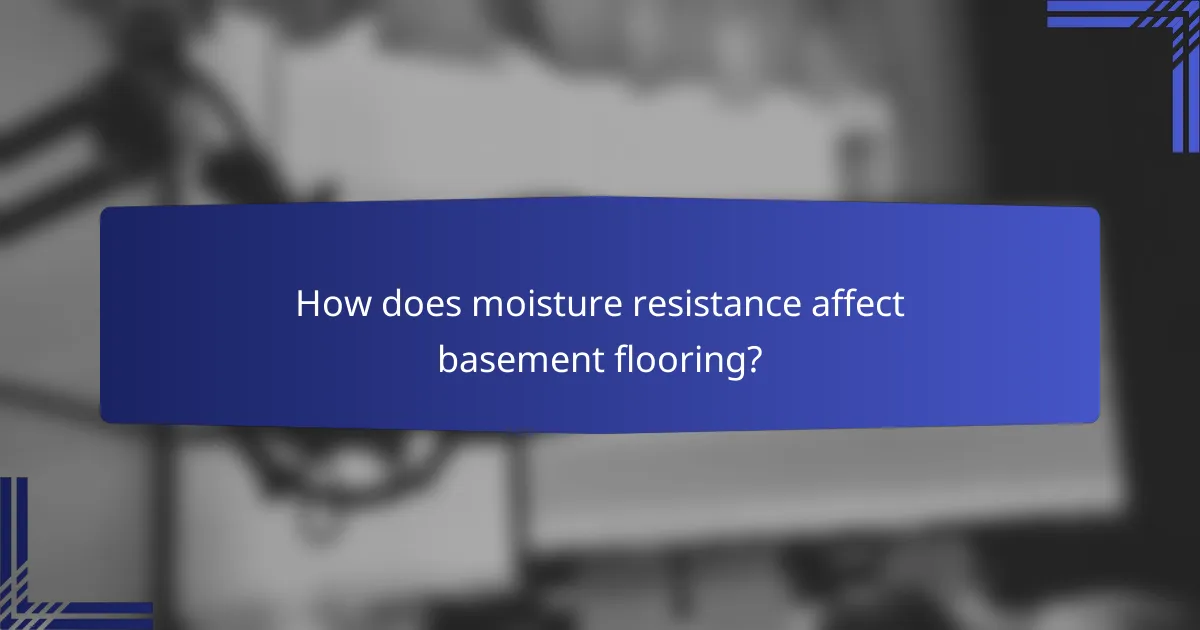
How does moisture resistance affect basement flooring?
Moisture resistance is crucial for basement flooring as it prevents water damage, mold growth, and structural issues. Choosing the right flooring material can significantly enhance the durability and longevity of your basement space.
Importance of moisture barriers
Moisture barriers are essential in basements to protect flooring from water seepage and humidity. These barriers, typically made of polyethylene or similar materials, are installed beneath the flooring to block moisture from the ground. Without a proper moisture barrier, even the most water-resistant flooring can suffer damage over time.
When selecting a moisture barrier, ensure it meets local building codes and is compatible with your chosen flooring material. Regular inspections and maintenance of the barrier can help prevent costly repairs in the future.
Waterproof vs. water-resistant materials
Waterproof materials are impervious to water, making them ideal for basements prone to flooding or high moisture levels. Examples include vinyl planks and ceramic tiles, which can withstand prolonged exposure to water without damage.
In contrast, water-resistant materials can repel water to some extent but may not hold up under extreme conditions. Laminate flooring, for instance, can resist spills but is not suitable for areas with high moisture. It’s important to evaluate the specific conditions of your basement when choosing between waterproof and water-resistant options.
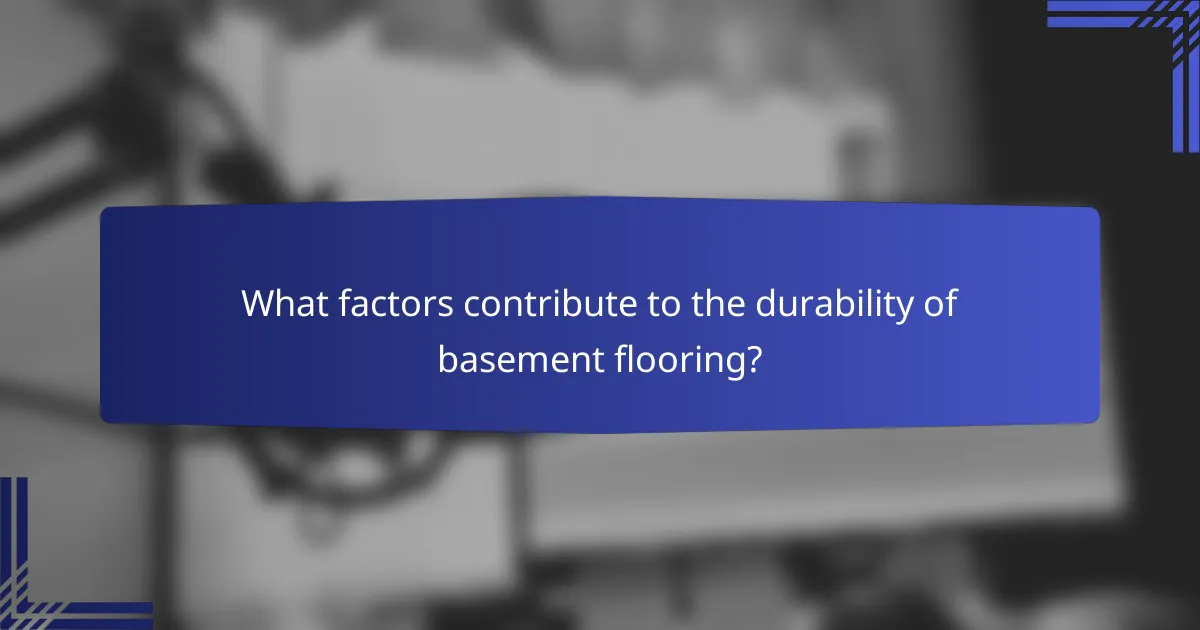
What factors contribute to the durability of basement flooring?
Durability in basement flooring is influenced by several key factors, including impact resistance, scratch resistance, and the longevity of materials. Selecting flooring that excels in these areas ensures it can withstand the unique challenges of a basement environment.
Impact resistance
Impact resistance refers to a flooring material’s ability to withstand heavy objects dropping or being moved across its surface. For basements, where storage is common, choosing materials like vinyl or tile can provide better protection against dents and cracks compared to softer options like carpet.
When evaluating impact resistance, consider the thickness and density of the flooring. Thicker materials generally offer greater protection, while softer materials may show damage more easily. Look for products that specify their impact resistance ratings to make informed choices.
Scratch resistance
Scratch resistance is crucial for maintaining the appearance of basement flooring, especially in high-traffic areas. Harder surfaces, such as ceramic tile or luxury vinyl, tend to resist scratches better than softer materials like laminate or wood.
To enhance scratch resistance, consider finishes that provide an additional protective layer. For instance, some vinyl products come with a wear layer that significantly improves their ability to resist scratches and scuffs, making them ideal for busy basements.
Longevity of materials
The longevity of flooring materials is essential for minimizing replacement costs and maintenance efforts. Materials like concrete, tile, and certain types of vinyl can last for decades when properly installed and maintained, while others may need replacement within a few years.
When selecting flooring, check for warranties that indicate expected lifespan. A longer warranty often correlates with higher durability. Additionally, consider the environmental conditions of your basement, such as humidity and temperature fluctuations, as these can impact the longevity of different flooring types.

How can style enhance basement spaces?
Style can significantly enhance basement spaces by creating a welcoming atmosphere that complements the rest of the home. Thoughtful design choices in color, materials, and layout can transform a basement from a utilitarian area into a stylish extension of living space.
Color and design trends
Current color trends for basements often include soft neutrals, deep blues, and earthy tones, which can make the space feel cozy and inviting. Incorporating lighter shades can help brighten the typically darker environment of a basement, while bold accent colors can add personality and vibrancy.
Design trends lean towards open layouts and multifunctional spaces. For example, using furniture that can serve multiple purposes, such as a sofa bed or a foldable table, maximizes utility without sacrificing style. Textured materials like reclaimed wood or stone can also add visual interest and warmth.
Matching decor styles
When choosing decor for a basement, it’s essential to ensure it aligns with the overall style of the home. For a modern home, sleek furniture and minimalistic decor work well, while a rustic home might benefit from vintage furnishings and natural materials.
Consider the existing elements in the basement, such as exposed beams or brick walls, and incorporate decor that highlights these features. For instance, industrial-style lighting can enhance a raw, unfinished look, while cozy textiles can soften the space and make it more inviting.
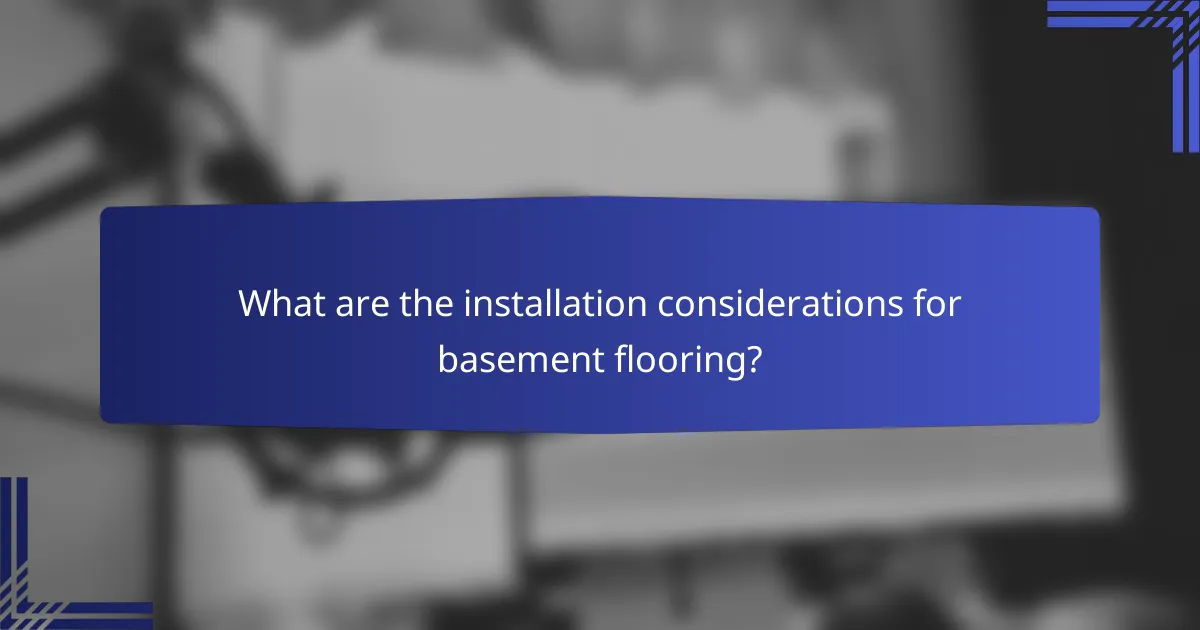
What are the installation considerations for basement flooring?
When installing flooring in a basement, key considerations include moisture resistance, subfloor preparation, and whether to hire professionals or tackle the project yourself. Proper planning can significantly impact the durability and aesthetics of the finished space.
Subfloor preparation
Subfloor preparation is crucial for basement flooring installation. Start by ensuring the concrete slab is clean, dry, and free from cracks. Moisture testing is recommended to determine if additional moisture barriers are necessary, as excess moisture can lead to mold and damage.
Consider installing a vapor barrier, especially if you live in a humid climate. This barrier can help protect your flooring material from moisture seeping up from the ground. Depending on the flooring type, you may also need to level the subfloor to create a smooth surface for installation.
Professional vs. DIY installation
Deciding between professional and DIY installation for basement flooring depends on your skill level and the complexity of the project. Hiring professionals can ensure a high-quality finish and adherence to local building codes, especially for materials that require precise installation techniques.
If you choose to go the DIY route, familiarize yourself with the specific requirements of your chosen flooring type. Resources such as online tutorials and manufacturer guidelines can be invaluable. However, be cautious of common pitfalls, such as inadequate moisture control or improper subfloor preparation, which can lead to costly repairs later on.
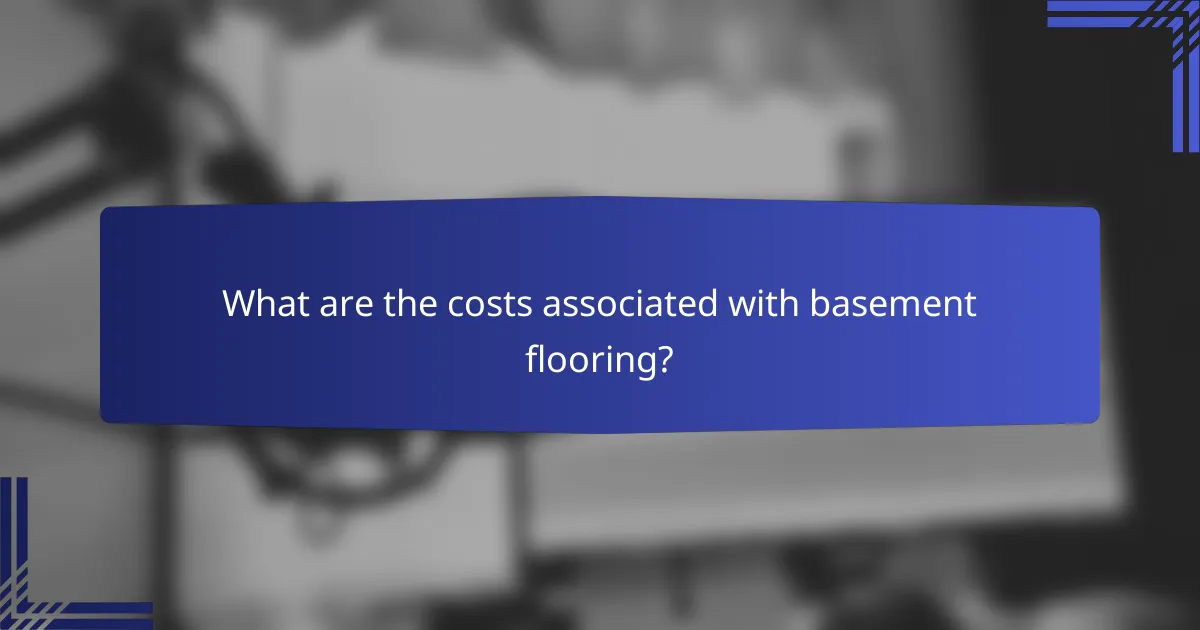
What are the costs associated with basement flooring?
The costs of basement flooring can vary widely based on materials, installation, and additional features like moisture barriers. Generally, homeowners can expect to spend anywhere from a few dollars to over a hundred dollars per square foot, depending on the choices made.
Material Costs
Material costs for basement flooring typically range from affordable options like vinyl and laminate, which can be as low as 5-15 USD per square foot, to more premium choices like tile or hardwood, which may cost 30-100 USD per square foot. It’s essential to consider moisture-resistant materials to prevent damage over time.
Installation Costs
Installation costs can add significantly to the overall expense, often ranging from 1-5 USD per square foot. Hiring a professional is advisable for complex materials, while DIY can save money if you have the skills. Always factor in the cost of any necessary underlayment or moisture barriers.
Additional Expenses
Additional expenses may include moisture mitigation systems, which can range from a few hundred to several thousand dollars, depending on the severity of the moisture issue. Other costs might involve baseboards, transitions, or finishing touches that enhance the overall look and functionality of the basement flooring.
